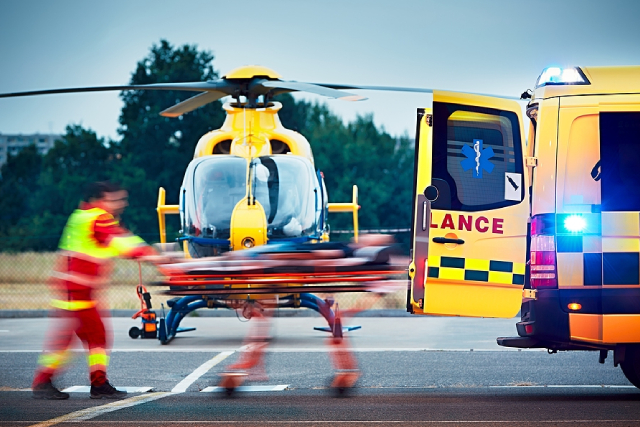
When faced with a medical emergency, every second counts. The choice between an air ambulance and a ground ambulance can significantly impact the outcome of a medical evacuation. Each mode of transport has its own set of advantages and limitations, making it crucial to understand which option best suits your needs during such critical moments.
Air ambulances are equipped with advanced medical equipment and staffed by highly trained medical professionals, offering rapid and efficient transportation for critically ill or injured patients. They can quickly cover long distances and access remote areas that ground ambulances cannot reach. Onboarding an air ambulance ensures that patients receive continuous medical care during transit, making it a critical option for severe cases. On the other hand, ground ambulances are more commonly used for short-distance transfers, providing a stable and reliable means of transport with the ability to navigate through city streets and local roads.
Pros of air ambulance
1. Speed and efficiency
Air ambulances, like those utilised for medical evacuations, offer unparalleled speed. When time is of the essence, such as in severe trauma cases or medical conditions requiring immediate intervention, the swift response of an air ambulance in Singapore can be life-saving. The ability to bypass traffic congestion and geographical barriers allows for faster transport to medical facilities, ensuring that patients receive the necessary care as quickly as possible.
2. Access to remote areas
One of the significant advantages of air ambulances is their ability to reach remote or inaccessible areas. In cases where road infrastructure is limited or non-existent, air ambulances can land in hard-to-reach locations, ensuring that even those in isolated areas can receive timely medical assistance. This is particularly beneficial for medical evacuation in Singapore, where certain regions may be challenging to access by ground transport.
3. Advanced medical care
As mentioned, air ambulances are equipped with state-of-the-art medical equipment and staffed by specialised medical teams, including doctors, nurses, and paramedics trained in critical care. This ensures that patients receive continuous medical attention and advanced life support during transit. The presence of advanced medical facilities on board can make a significant difference in patient outcomes, especially during long-distance transfers.
Cons of air ambulance
1. Cost
One of the main drawbacks of air ambulances is the cost. The specialised equipment, highly trained staff, and operational expenses associated with air ambulance services contribute to their high price tag. Insurance coverage may vary, and not all policies fully cover air ambulance transport, making it a potentially expensive option for patients and their families.
2. Weather and environmental constraints
Air ambulances are subject to weather conditions and other environmental factors that can impact their ability to operate. Severe weather, such as heavy rain, fog, or strong winds, can delay or prevent air ambulances from taking off or landing safely. These constraints can limit the reliability of air ambulance services in certain situations.
Pros of ground ambulance
1. Availability and accessibility
Ground ambulances are more widely available and accessible compared to air ambulances. They are commonly stationed at hospitals, clinics, and emergency response centres, making them readily available for immediate dispatch. This accessibility ensures that patients can quickly receive medical attention and be transported to nearby healthcare facilities.
2. Cost-effective
Ground ambulances are generally more cost-effective than air ambulances. The lower operational costs and widespread availability make them a more affordable option for patients and healthcare systems. Insurance policies are also more likely to cover ground ambulance services, reducing the financial burden on patients and their families.
3. Stability and comfort
Ground ambulances provide a stable and comfortable means of transport for patients. The smooth ride on the road, coupled with the ability to provide continuous medical care, ensures that patients remain stable during transit. Additionally, ground ambulances can accommodate family members or caregivers, offering emotional support to patients.
Cons of ground ambulance
1. Traffic and road conditions
One of the significant limitations of ground ambulances is their vulnerability to traffic and road conditions. In urban areas with heavy traffic congestion, ground ambulances may experience delays in reaching the destination. Poor road infrastructure or accidents can also impact the efficiency of ground transport, potentially delaying medical care.
2. Limited range
Ground ambulances are best suited for short-distance transfers within a city or local area. They may not be practical for long-distance medical evacuations, especially when time is a critical factor. In such cases, the slower speed of ground ambulances compared to air transport can be a disadvantage.
3. Restricted access
Ground ambulances may face challenges in accessing remote or difficult-to-reach areas. In regions with limited road infrastructure or natural obstacles, ground transport may not be feasible, necessitating the use of air ambulances for medical evacuation.
Making the right choice
When deciding between an air ambulance and a ground ambulance, several factors need to be considered. The urgency of the medical situation, distance to the nearest appropriate medical facility, patient’s condition, and financial considerations all play a crucial role in making the right choice.
- Urgency and distance
For life-threatening emergencies or situations requiring immediate medical intervention, an air ambulance may be the best option due to its speed and ability to cover long distances quickly. For less critical conditions or short-distance transfers, ground ambulances provide a reliable and cost-effective means of transport.
- Patient’s condition
The patient’s medical condition is a key factor in choosing the appropriate mode of transport. Patients requiring continuous advanced medical care or those in critical condition may benefit more from the specialised equipment and medical personnel available on air ambulances. For stable patients, ground ambulances offer sufficient care and comfort during transit.
- Financial considerations
Cost is a significant consideration when choosing between air and ground ambulances. It is essential to understand the coverage provided by insurance policies and weigh the potential out-of-pocket expenses. In many cases, ground ambulances offer a more affordable solution, while air ambulances, despite their higher cost, provide critical benefits in life-threatening situations.
Conclusion
Choosing between an air ambulance and a ground ambulance depends on various factors, including the urgency of the medical situation, distance, patient’s condition, and financial considerations. Both options have their own set of advantages and limitations, making it essential to evaluate the specific needs of each situation.
When it comes to medical evacuation in Singapore, EMA Global stands out as a specialist in providing world-class medical evacuation, repatriation, and air ambulance services. Our expertise and commitment to patient care ensure that you receive the best possible assistance during medical emergencies.

